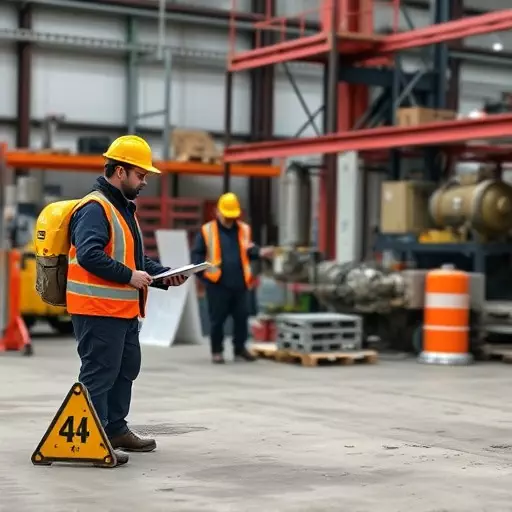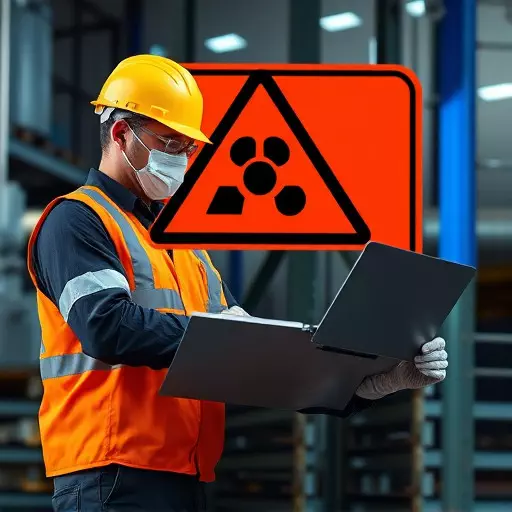Ladder safety is a critical component of comprehensive workplace safety training, focusing on OSHA compliance. This involves equipping employees with knowledge about potential risks like unstable surfaces and improper ladder positioning. Regular hazard identification training empowers workers to recognize and mitigate risks, fostering a safer work environment. Correct selection, setup, and use of ladders, along with proper Personal Protective Equipment (PPE), are essential for preventing accidents and ensuring compliance. Regular inspections and maintenance, combined with ongoing training and open communication, reinforce ladder safety in daily operations.
Ladder safety is an essential component of any comprehensive workplace safety program. This article explores critical aspects of ladder safety training, designed to help employees navigate OSHA compliance requirements effectively. From understanding the basics to identifying hazards, selecting and setting up ladders appropriately, and incorporating safety practices into daily routines, each section provides valuable insights for enhancing workplace safety. Effective ladder safety training not only reduces accidents but also fosters a culture of continuous compliance and proactive risk management.
- Understanding Ladder Safety: The Basics Every Employee Needs to Know
- Identifying Hazards: A Crucial Step in OSHA Compliance Training
- Proper Ladder Selection and Setup for Different Work Environments
- Using Personal Protective Equipment (PPE) Effectively During Ladder Operations
- Common Ladder-Related Accidents: Prevention and Response Strategies
- Inspecting and Maintaining Ladders to Ensure Workplace Safety
- Incorporating Ladder Safety into Daily Routines: Best Practices for Continuous Compliance
Understanding Ladder Safety: The Basics Every Employee Needs to Know

Understanding Ladder Safety: The Basics Every Employee Needs to Know
Ladder safety is an integral component of comprehensive workplace safety training. Employees need to be equipped with the knowledge to identify potential hazards associated with ladder use, such as unstable surfaces, inappropriate ladder selection, and improper positioning. Regular hazard identification training ensures that workers are vigilant in recognizing and mitigating risks before they escalate. This includes understanding OSHA (Occupational Safety and Health Administration) compliance standards, which mandate specific safety protocols for using ladders in the workplace.
By focusing on these fundamentals, organizations can foster a culture of safety where employees actively participate in their own protection. Effective ladder safety training goes beyond simply demonstrating how to climb; it empowers workers with the critical thinking skills needed to assess and minimize risks associated with ladder use. This proactive approach not only enhances individual safety but also contributes to overall workplace safety compliance.
Identifying Hazards: A Crucial Step in OSHA Compliance Training

Identifying hazards is a fundamental step in any comprehensive workplace safety training program, especially when it comes to OSHA compliance. It involves thoroughly assessing the work environment and tasks to recognize potential risks and dangers that employees may encounter on a regular basis. By implementing effective hazard identification training, organizations can ensure that they meet the strict standards set by OSHA, fostering a safer and more productive workforce.
During this critical phase, employees are equipped with the knowledge to spot various hazards, such as slippery surfaces, heavy equipment, electrical risks, or even ergonomic issues. Through interactive exercises and real-world scenarios, workers learn to evaluate their surroundings and anticipate potential pitfalls. This proactive approach not only empowers individuals but also allows for the development of tailored safety protocols, ensuring that every task is executed with the highest level of caution.
Proper Ladder Selection and Setup for Different Work Environments

Selecting and setting up ladders correctly is paramount in any work environment, ensuring both efficiency and workplace safety. The first step involves identifying the task at hand and the specific ladder type required; steps, extension, or platform ladders serve diverse needs. Understanding the capacity and stability of each ladder type is crucial for OSHA compliance training.
For instance, in a construction site, heavy-duty extension ladders capable of supporting significant weight are essential. Conversely, a retail store might require sturdy step ladders for stock management. Proper setup involves ensuring the ladder’s feet are placed on level ground or a stable surface, and the ladder should be positioned at the correct angle to prevent tipping. Regular maintenance checks, including inspection for damage or wear, further contribute to safe ladder usage in various work settings.
Using Personal Protective Equipment (PPE) Effectively During Ladder Operations

When engaging in ladder operations, proper use of Personal Protective Equipment (PPE) is paramount for workplace safety training. This includes hard hats to protect against falling objects, safety shoes or boots to prevent slips and falls, and eye protection to guard against debris. Gloves should be worn to enhance grip and shield hands from potential hazards. Understanding when and how to utilize this equipment is crucial, making hazard identification training a key component of any comprehensive workplace safety program.
Effective PPE utilization ensures OSHA compliance training is not just a theoretical concept but a practical reality. It empowers workers to mitigate risks during ladder use, whether for routine tasks or emergency situations. Regular refreshers on PPE fitting and usage, along with hands-on practice, are essential elements of ongoing ladder safety training, ensuring folks are prepared to navigate any workplace environment safely and confidently.
Common Ladder-Related Accidents: Prevention and Response Strategies

Common Ladder-Related Accidents: Prevention and Response Strategies
Ladder-related accidents are a significant concern in many workplaces, leading to injuries and even fatalities. Identifying and mitigating these hazards is crucial for effective workplace safety training. One of the primary causes is improper ladder setup and placement, which can result in tip-overs or instability. Training should emphasize the importance of setting ladders on stable, level surfaces, using the appropriate height for the task, and securing them where necessary.
Another frequent accident type involves slips and falls while ascending or descending. This can be prevented by ensuring ladders are positioned away from traffic zones and potential tripping hazards. OSHA compliance training highlights the need for workers to always face the ladder when climbing, maintaining three-point contact (two hands and one foot, or two feet and one hand), and using safety equipment like ropes or guardrails where applicable. Quick response strategies include providing first aid, securing the individual, and promptly reporting the incident for further investigation and improved workplace safety measures.
Inspecting and Maintaining Ladders to Ensure Workplace Safety

Regular inspection and proper maintenance of ladders are essential components of workplace safety training. Before using any ladder, employees should be taught to conduct a thorough visual check for any signs of damage or wear. This includes examining rungs, side rails, and feet for cracks, breaks, loose parts, or excessive corrosion. Even minor issues can pose significant hazards, leading to accidents and potential OSHA non-compliance.
During maintenance checks, workers should ensure ladders are properly secured and stabilised, especially for extended reach tasks. Regular cleaning and oiling of moving parts can prolong ladder lifespan and maintain their functionality. Proper ladder selection based on the task at hand is also crucial. Understanding the load capacity and dimensions suitable for specific jobs is vital for hazard identification training, ensuring both efficiency and safety in the workplace.
Incorporating Ladder Safety into Daily Routines: Best Practices for Continuous Compliance

Incorporating ladder safety into daily routines is a key aspect of comprehensive workplace safety training. It’s not enough to conduct occasional OSHA compliance training sessions; ladder safety must be integrated into the fabric of an organization’s culture. Best practices include regular, hands-on demonstrations and refresher courses that cover hazard identification training for ladders. This ensures employees are constantly reminded of proper usage, risk mitigation techniques, and emergency protocols specific to ladder-related tasks.
For sustained compliance, management should encourage open communication channels where workers can report unsafe conditions or near-miss incidents related to ladders without fear of retaliation. Additionally, providing accessible resources like online modules or printed guides that outline essential safety guidelines fosters a culture of self-awareness and proactive safety measures. Regular inspections of ladder equipment, proper storage, and well-maintained work environments further reinforce the importance of ladder safety in day-to-day operations.
